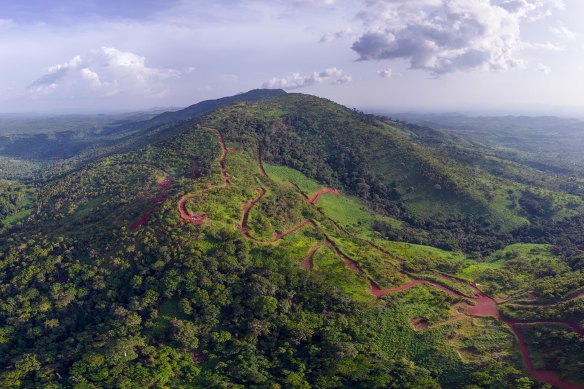Save articles for later
Add articles to your saved list and come back to them any time.
The Chinese government is close to backing Rio Tinto’s newest mine in the heart of a remote African chimpanzee rainforest, where the global resources giant expects to dig up 1.5 billion tonnes of iron ore over the next 26 years, stimulating its growth and expenses.
The dual-listed miner, headquartered in Melbourne and London, is on track to tap into the world’s largest high-grade iron ore deposit by 2025 in Guinea’s Simandou mountains, a sensitive habitat for endangered western chimpanzees.
The Simandou mountains in Guinea contain high-grade iron ore.Credit: Rio Tinto
The deposit in south-eastern Guinea is shared between a number of Chinese state-owned enterprises, Rio’s Simfer consortium and the Guinea government. Rio says it will spend $6.2 billion to galvanise its iron ore output from the project and fund its share of the $US23.2 billion ($35.4 billion) mine.
A Chinese railway builder, constructing the 600 kilometre cross-country tracks needed for the ore to reach a deep water port on the Atlantic coast, was exposed two years ago for blasting without plans to protect the apes and their habitat.
Rio boss Jakob Stausholm said the miner was keenly focused on the environment, sustainability and governance aspects of its Guinea operations.
“We have come up with a solution around the mine that really takes into consideration ESG matters, protecting the rainforests with the chimpanzees. It actually leads to much higher cost, but we just have to draw a line and get these things right,” Stausholm said.
Production from Simandou at full capacity will reach 120 million tonnes a year, equating to nearly 5 per cent of the global seaborne iron ore market. Rio’s share is 27 million tonnes.
Stausholm said iron ore mines around the world are running down reserves and Simandou’s output will be comfortably absorbed by steelmakers without affecting prices.
“I do think we are pretty close to getting approval from the Chinese authorities. Sanction is imminent, and this project is all about execution,” Stausholm said.
“It’s a different product from in the Pilbara. This is the highest grade iron ore on the planet. The only product that it goes into heads-on competition with is the iron ore from northern Brazil.”
The low-impurity iron ore extracted from the Guinea operation has an average grade of 65 per cent and is suitable for DIR electric arc furnaces, a form of green steelmaking that will significantly help Rio’s customers reduce their planet-warming carbon emissions, he said.
Rio told investors it was well-positioned to capitalise on sustained commodity demand driven by decarbonisation, with copper demand to grow by 4 per cent a year to 2035. Rio’s capital expenditure will reach $10 billion a year over the next three years as ramps up its iron ore output, but it has deferred its spending on decarbonisation, lowering its guidance to between $5 billion and $6 billion to 2030. Previously it was $7.5 billion.
The Business Briefing newsletter delivers major stories, exclusive coverage and expert opinion. Sign up to get it every weekday morning.
Most Viewed in Business
From our partners
Source: Read Full Article
